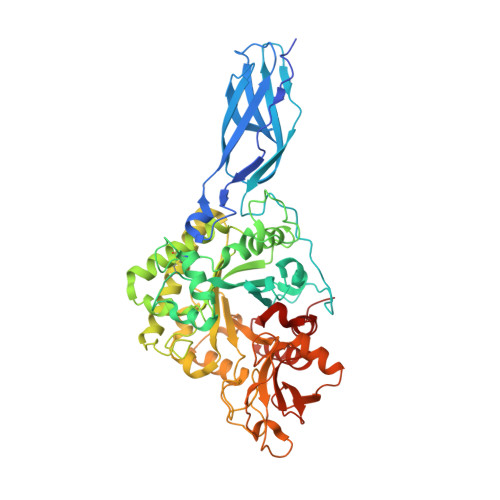Structure, Catalysis, and Inhibition of OfChi-h, the Lepidoptera-exclusive Insect Chitinase.
Liu, T., Chen, L., Zhou, Y., Jiang, X., Duan, Y., Yang, Q.(2017) J Biological Chem 292: 2080-2088
- PubMed: 28053084
- DOI: https://doi.org/10.1074/jbc.M116.755330
- Primary Citation of Related Structures:
5GPR, 5GQB - PubMed Abstract:
Chitinase-h (Chi-h) is of special interest among insect chitinases due to its exclusive distribution in lepidopteran insects and high sequence identity with bacterial and baculovirus homologs. Here Of Chi-h, a Chi-h from Ostrinia furnacalis , was investigated. Crystal structures of both Of Chi-h and its complex with chitoheptaose ((GlcN) 7 ) reveal that Of Chi-h possesses a long and asymmetric substrate binding cleft, which is a typical characteristics of a processive exo-chitinase. The structural comparison between Of Chi-h and its bacterial homolog Sm ChiA uncovered two phenylalanine-to-tryptophan site variants in Of Chi-h at subsites +2 and possibly -7. The F232W/F396W double mutant endowed Sm ChiA with higher hydrolytic activities toward insoluble substrates, such as insect cuticle, α-chitin, and chitin nanowhisker. An enzymatic assay demonstrated that Of Chi-h outperformed Of ChtI, an insect endo-chitinase, toward the insoluble substrates, but showed lower activity toward the soluble substrate ethylene glycol chitin. Furthermore, Of Chi-h was found to be inhibited by N , N ', N ″-trimethylglucosamine- N , N ', N ″, N ″'-tetraacetylchitotetraose (TMG-(GlcNAc) 4 ), a substrate analog which can be degraded into TMG-(GlcNAc) 1-2 Injection of TMG-(GlcNAc) 4 into 5th-instar O. furnacalis larvae led to severe defects in pupation. This work provides insights into a molting-indispensable insect chitinase that is phylogenetically closer to bacterial chitinases than insect chitinases.
- From the State Key Laboratory of Fine Chemical Engineering, School of Life Science and Biotechnology and School of Software, Dalian University of Technology, 2 Linggong Road, Dalian 116024, China and.
Organizational Affiliation:

















